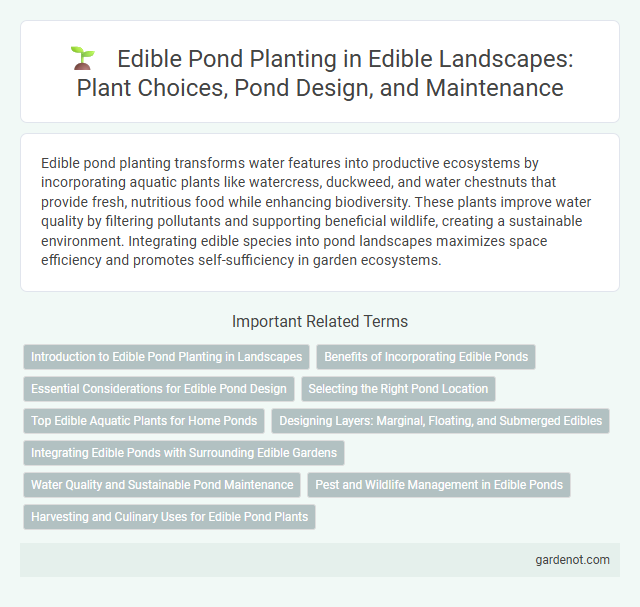Edible pond planting transforms water features into productive ecosystems by incorporating aquatic plants like watercress, duckweed, and water chestnuts that provide fresh, nutritious food while enhancing biodiversity. These plants improve water quality by filtering pollutants and supporting beneficial wildlife, creating a sustainable environment. Integrating edible species into pond landscapes maximizes space efficiency and promotes self-sufficiency in garden ecosystems.
Introduction to Edible Pond Planting in Landscapes
Edible pond planting integrates water-based food crops like watercress, wild rice, and water chestnuts into landscape designs, enhancing biodiversity and aesthetic value. These plants contribute to natural water filtration, support aquatic wildlife, and provide fresh, sustainable food sources. Incorporating edible pond plants optimizes space while promoting ecological balance and ecosystem services in residential and commercial landscapes.
Benefits of Incorporating Edible Ponds
Incorporating edible ponds enhances biodiversity by creating habitats for pollinators and beneficial aquatic life, which supports natural pest control and improves crop yields. These ponds serve as a sustainable water source for irrigation and offer fresh, nutrient-rich produce like aquatic herbs and vegetables, contributing to food security. Integrating edible ponds also promotes eco-friendly landscaping by reducing the need for chemical fertilizers and conserving water through efficient natural cycles.
Essential Considerations for Edible Pond Design
Edible pond planting requires careful attention to water quality, plant selection, and ecosystem balance to ensure a thriving, sustainable environment. Incorporating native aquatic edible plants such as watercress, mint, and water chestnuts supports biodiversity while providing fresh harvests. Proper pond design addresses factors like sunlight exposure, depth variation, and nutrient management to prevent algae overgrowth and promote healthy plant growth.
Selecting the Right Pond Location
Selecting the right pond location involves assessing sunlight exposure, as edible pond plants like watercress and lotus require at least six hours of direct sunlight daily for optimal growth. Soil type and drainage are critical; a site with clay or loamy soil helps retain water and supports root stability, while avoiding areas prone to flooding or erosion ensures long-term pond health. Proximity to natural water sources and ease of access for maintenance also enhance the sustainability and productivity of an edible pond landscape.
Top Edible Aquatic Plants for Home Ponds
Top edible aquatic plants for home ponds include watercress, lotus, and water chestnut, each offering unique nutritional benefits and enhancing pond biodiversity. Watercress thrives in clean, flowing water and provides a peppery, vitamin-rich green ideal for salads and garnishes. Lotus roots and seeds supply carbohydrates and proteins, while water chestnuts offer a crunchy texture rich in fiber, making them excellent choices for integrating sustainable, edible landscaping into backyard water features.
Designing Layers: Marginal, Floating, and Submerged Edibles
Edible pond planting involves strategic design of layered vegetation, incorporating marginal, floating, and submerged edibles to maximize productivity and ecosystem health. Marginal plants such as watercress and marsh herbs thrive at pond edges, providing habitat and nutrient uptake, while floating edibles like water chestnut and dwarf water lettuce offer surface coverage and fruit harvest. Submerged plants including wild celery and eelgrass oxygenate water and filter nutrients, creating a balanced, nutrient-rich aquatic environment ideal for sustainable edible landscaping.
Integrating Edible Ponds with Surrounding Edible Gardens
Integrating edible ponds with surrounding edible gardens enhances biodiversity by creating a seamless habitat for aquatic and terrestrial plants such as watercress, cattails, and berry bushes. Edible pond planting supports natural water filtration through plants like duckweed and pickerelweed while providing fresh herbs and vegetables for harvest. This harmonious design maximizes space efficiency and promotes sustainable food production by linking water-based crops with garden-grown produce like tomatoes, kale, and herbs.
Water Quality and Sustainable Pond Maintenance
Edible pond planting enhances water quality by reducing nutrient runoff and promoting natural filtration through aquatic plants like watercress and duckweed, which absorb excess nitrogen and phosphorus. These plants create a balanced ecosystem that minimizes algae growth, supports beneficial microorganisms, and maintains clear, oxygen-rich water. Sustainable pond maintenance relies on periodic harvesting of edible plants to prevent overgrowth, combined with organic practices that avoid chemical fertilizers and pesticides, ensuring long-term ecosystem health and productivity.
Pest and Wildlife Management in Edible Ponds
Effective pest and wildlife management in edible pond planting centers on maintaining ecological balance through integrated strategies such as introducing natural predators and using organic repellents. Planting native species and creating habitat diversity can reduce pest populations and discourage invasive wildlife from damaging crops. Regular monitoring and water quality management also help minimize pest outbreaks and support the health of both edible plants and surrounding aquatic life.
Harvesting and Culinary Uses for Edible Pond Plants
Edible pond plants such as watercress, lotus roots, and water chestnuts offer diverse harvesting opportunities throughout their growing seasons, providing fresh, nutrient-rich ingredients. These aquatic plants can be integrated into a variety of culinary dishes, including salads, stir-fries, soups, and smoothies, enhancing both flavor and nutritional value. Sustainable harvesting practices ensure continuous growth and ecosystem balance, promoting long-term productivity of the edible pond landscape.
Edible pond planting Infographic

 gardenot.com
gardenot.com